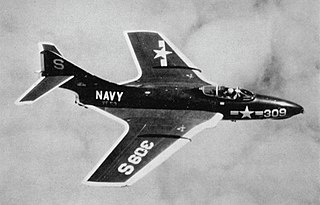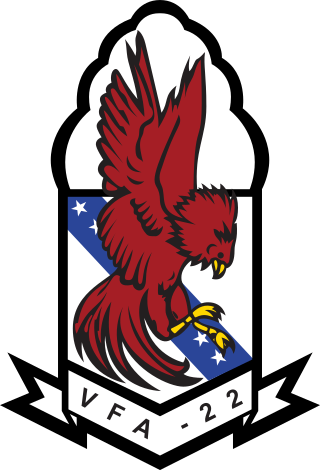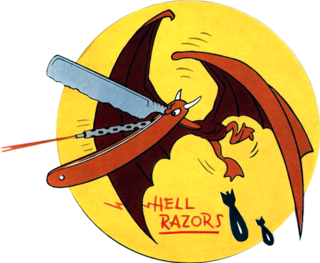
The North American FJ-2 and FJ-3 Fury are a series of swept-wing and carrier-capable fighters for the United States Navy and Marine Corps. The FJ-2 resulted from an effort to navalize the North American F-86 Sabre operated by the United States Air Force. These aircraft feature folding wings, and a longer nose landing strut designed to increase angle of attack upon launch and to accommodate a longer oleo to absorb the shock of hard landings on an aircraft carrier deck.

The Grumman F9F/F-9 Cougar is a carrier-based jet-powered fighter aircraft designed and produced by the American aircraft manufacturer Grumman.

Fighter Squadron 61 (VF-61), the Jolly Rogers, was a fighter squadron of the United States Navy. Originally established as VF-17 on 1 January 1943, it was redesignated as VF-5B on 15 November 1946, redesignated as VF-61 on 28 July 1948 it was disestablished on 15 April 1959. It was the first navy squadron to be designated VF-17.

Fighter Squadron 33 (VF-33) was an aviation unit of the United States Navy. Originally established on 11 October 1948 it was disestablished on 1 October 1993. It was the second U.S. Navy squadron to be designated VF-33.

Fighter Squadron 111 (VF-111), also known as the Sundowners, was a fighter squadron of the United States Navy. Originally established as Fighter Squadron 11 (VF-11) on 10 October 1942, it was redesignated as VF-11A on 15 November 1946, redesignated as VF-111 on 15 July 1948 and disestablished on 19 January 1959. On 20 January, another squadron, VF-111 (1956-95) then assumed the designation until its de-establishment in 1995. In November 2006, VFC-13 Detachment Key West was redesignated as VFC-111, taking on the Sundowner insignia and callsign.

Fighter Squadron 143 or VF-143 was an aviation unit of the United States Navy originally established as a Naval Reserve squadron VF-821 on 20 July 1950 it was redesignated VF-143 on 4 February 1953 and disestablished on 1 April 1958.

Fighter Squadron 194 (VF-194) was an aviation unit of the United States Navy. It was originally established as VF-91 on 26 March 1952, redesignated VF-194 on 1 August 1963 and disestablished on 1 March 1978. It was the third US Navy squadron to be designated VF-194.

Fighter Squadron 53, or VF-53Iron Angels was an aviation unit of the United States Navy in service from 20 July 1950 to 29 January 1971. Originally established as reserve squadron VF-721 on 20 July 1950, it was redesignated as VF-141 on 4 February 1953 and then redesignated as VF-53 on 15 October 1963. The squadron was disestablished on 29 January 1971. It was the fourth US Navy squadron to be designated as VF-53.

VFA-22, Strike Fighter Squadron 22, also known as the "Fighting Redcocks", are a United States Navy F/A-18F Super Hornet fighter squadron stationed at Naval Air Station Lemoore, California. Their tail code is NA and their radio callsign alternates between "Beef" and "Beef Eater".

Fighter Squadron 62 or VF-62 was an aviation unit of the United States Navy. Originally established on 1 July 1955 it was disestablished on 1 October 1969.

Attack Squadron 174 (VA-174) also known as the "Hellrazors" was a United States Navy attack squadron based at Naval Air Station Cecil Field, Florida, and were attached to Light Attack Wing One. It was commissioned from 1944 to 1988.

The North American FJ-1 Fury was an early turbojet-powered carrier-capable fighter aircraft used by the United States Navy (USN). Developed by North American Aviation (NAA) starting in 1945, it became the first jet aircraft in USN service to serve at sea under operational conditions. This first version of the FJ was a straight-winged jet, briefly operational during the transition to more successful designs. An evolution of the FJ-1 would become the land-based XP-86 prototype of the United States Air Force's enormously influential F-86 Sabre, which in turn formed the basis for the Navy's carrier-based, swept-winged North American FJ-2/-3 Fury.

VF-121 of the US Navy was a former Pacific Fleet Replacement Air Group (RAG) unit. Originally established on 1 July 1946, as VF-781, it was redesignated as VF-121 on 4 February 1953 and disestablished on 30 September 1980. On 11 April 1958 it changed duty from Fleet Squadron to Fleet Replacement Squadron and was later charged with the training of Navy F-4 Phantom flight and maintenance crews.

All Weather Fighter Squadron 3 was a designation which was used by two separate U.S. Navy aviation squadrons. The first squadron to use the designation was established as Composite Squadron THREE (VC-3) on 20 May 1943, was redesignated All Weather Fighter Squadron THREE on 1 July 1956 and was disestablished on 2 May 1958. The second squadron to use the designation was established as "Navy Air Training Unit-Pacific (NATUPAC)" on 22 May 1944, was redesignated "Night Development Squadron Pacific (NightDevRonPac)" on 6 April 1946, then "Fighter All Weather Training Unit Pacific (FAWTUPAC)" on 1 September 1948 and finally, on the same day as the first squadron designated VF(AW)-3 was disestablished, 2 May 1958, was redesignated "All Weather Fighter Squadron THREE (VF ". This second squadron to carry the VF -3 designation adopted the insignia and nickname "Blue Nemesis" from the first VF -3 and was the only U.S. Navy unit to be assigned to the North American Air Defense Command.
VC-10 Composite SquadronChallengers was a United States Navy aircraft squadron. It was originally known as the Mallards in 1943, but when assigned the F-8 Crusader the squadron pilots unofficially used the name "Challengers". The squadron was formally known as the Challengers from 1961 through 1993.

VA-112 was an Attack Squadron of the U.S. Navy. It was established as Bomber-Fighter Squadron VBF-11 on 9 April 1945, redesignated Fighter Squadron VF-12A on 15 November 1946, then as VF-112 on 15 July 1948. It was finally redesignated as VA-112 on 15 February 1959. The squadron was disestablished on 10 October 1969. Its nickname from 1961 to 1969 was the Broncos.

VA-153 was an Attack Squadron of the U.S. Navy. During a 1949 reorganization of the Naval Air Reserve, a Fighter Squadron at NAS New York was redesignated Fighter Squadron VF-831. It was called to active duty on 1 February 1951. The squadron was redesignated as VF-153 on 4 February 1953, and finally as VA-153 on 15 December 1956. It was disestablished on 30 September 1977. The squadron's nickname was the Blue Tail Flies from 1953 onward.

VF-13 was a Fighter Squadron of the U.S. Navy, established on 2 August 1948 and disestablished on 1 October 1969. It was the second squadron to be assigned the VF-13 designation, the original VF-13 Black Cats was established on 2 November 1943 and disestablished on 20 October 1945.
VF-43 was a fighter squadron of the U.S. Navy. The squadron was originally established as Fighter Squadron 74A (VF-74A) on 1 May 1945, it was redesignated Fighter Squadron 74 (VF-74) on 1 August 1945, redesignated VF-1B on 15 November 1946, redesignated VF-21 on 1 September 1948, redesignated as Attack Squadron 43 (VA-43) Challengers on 1 July 1959 and Fighter Squadron 43 (VF-43) on 1 June 1973. It was disestablished on 1 July 1994.
Fighter Squadron 122 or VF-122 was an aviation unit of the United States Navy. Originally established as Reserve Squadron 783 (VF-783) it was called to active duty on 2 August 1950, it was re-designated VF-122 on 4 February 1953 and disestablished on 10 April 1958.



















